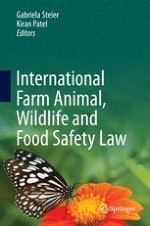2017 | OriginalPaper | Buchkapitel
14. Perspectives and Predicaments of GMO Salmon
verfasst von : Nicole Negowetti, M.A.; J.D.
Erschienen in: International Farm Animal, Wildlife and Food Safety Law
Aktivieren Sie unsere intelligente Suche, um passende Fachinhalte oder Patente zu finden.
Wählen Sie Textabschnitte aus um mit Künstlicher Intelligenz passenden Patente zu finden. powered by
Markieren Sie Textabschnitte, um KI-gestützt weitere passende Inhalte zu finden. powered by
